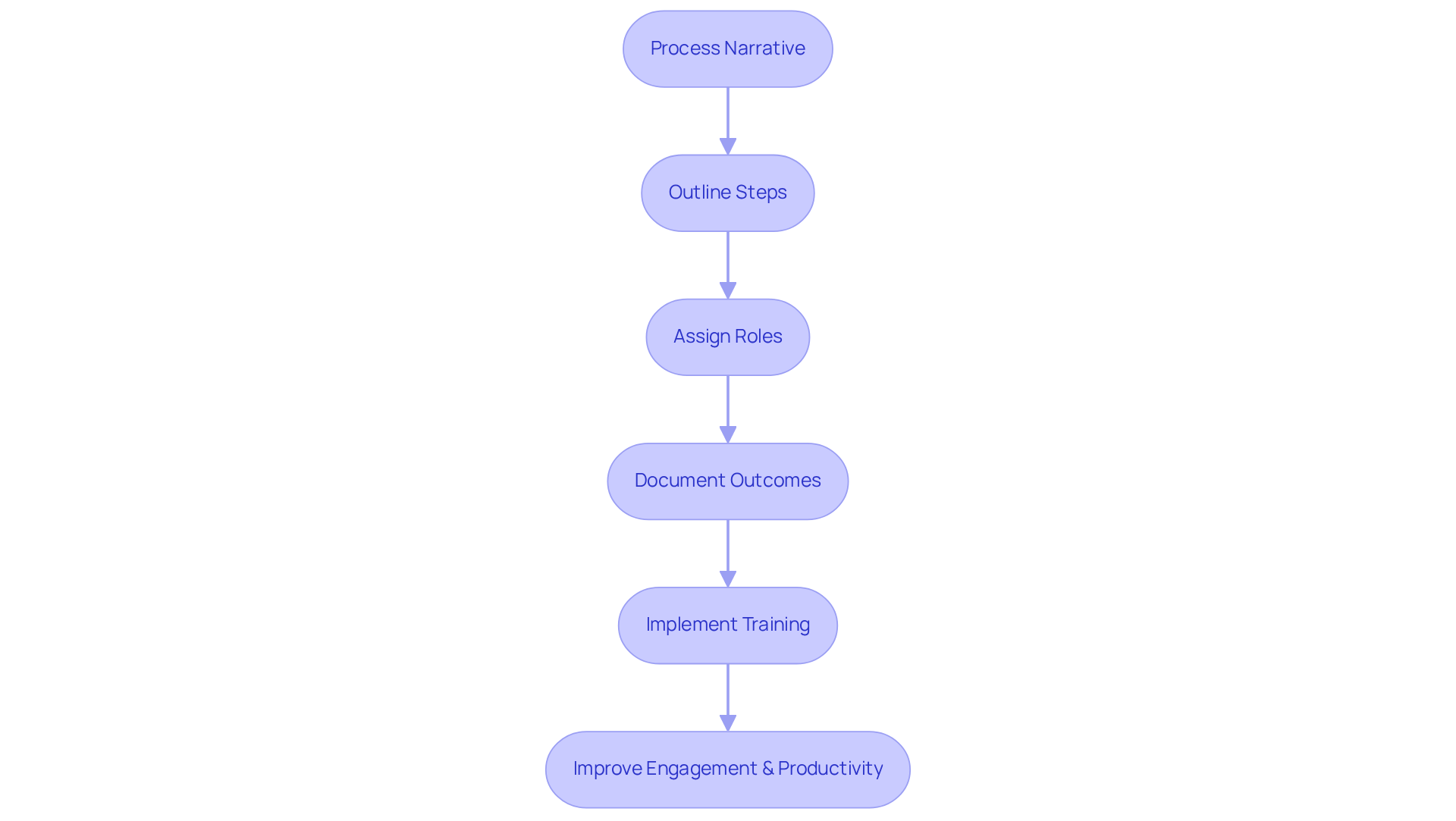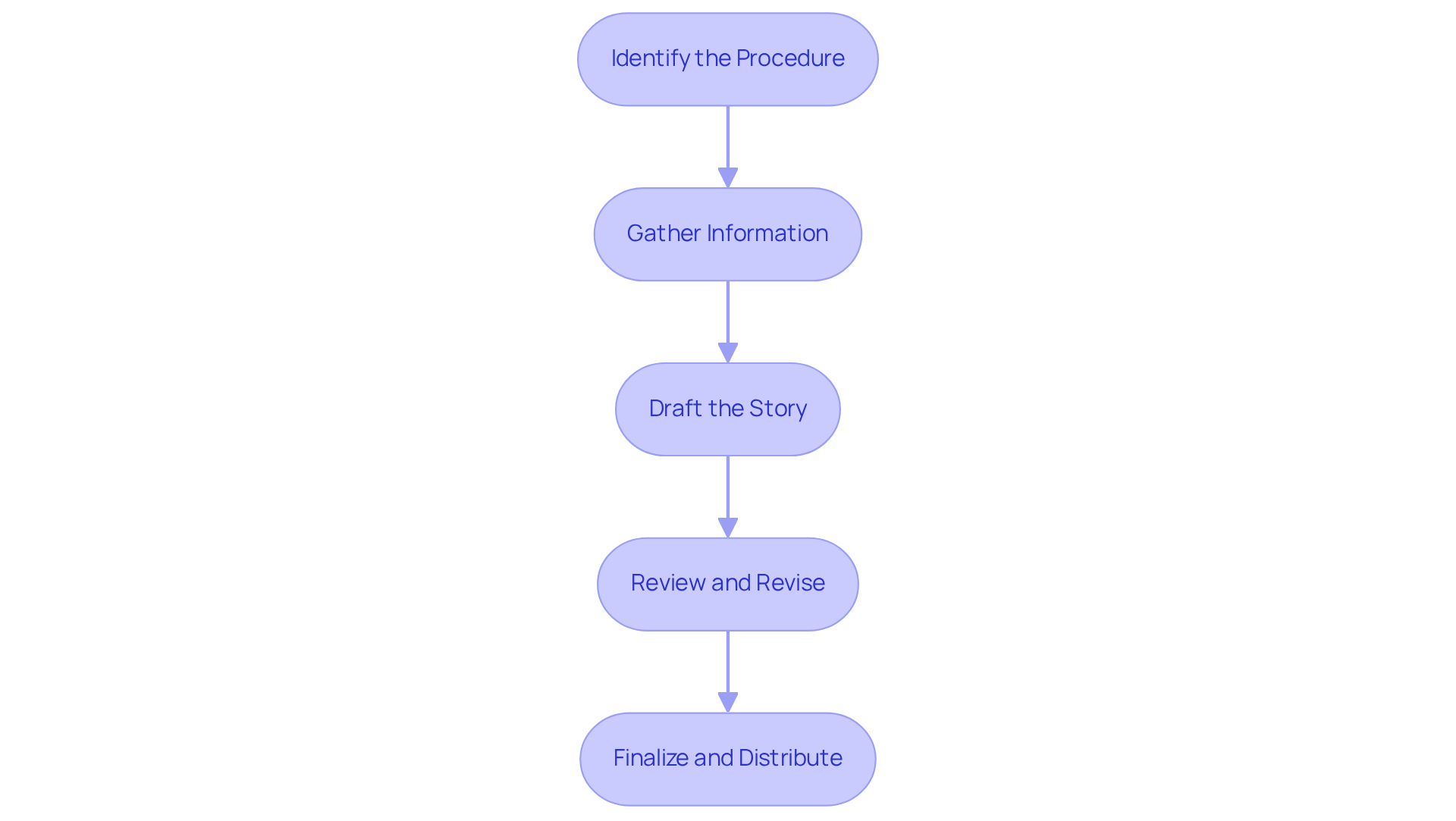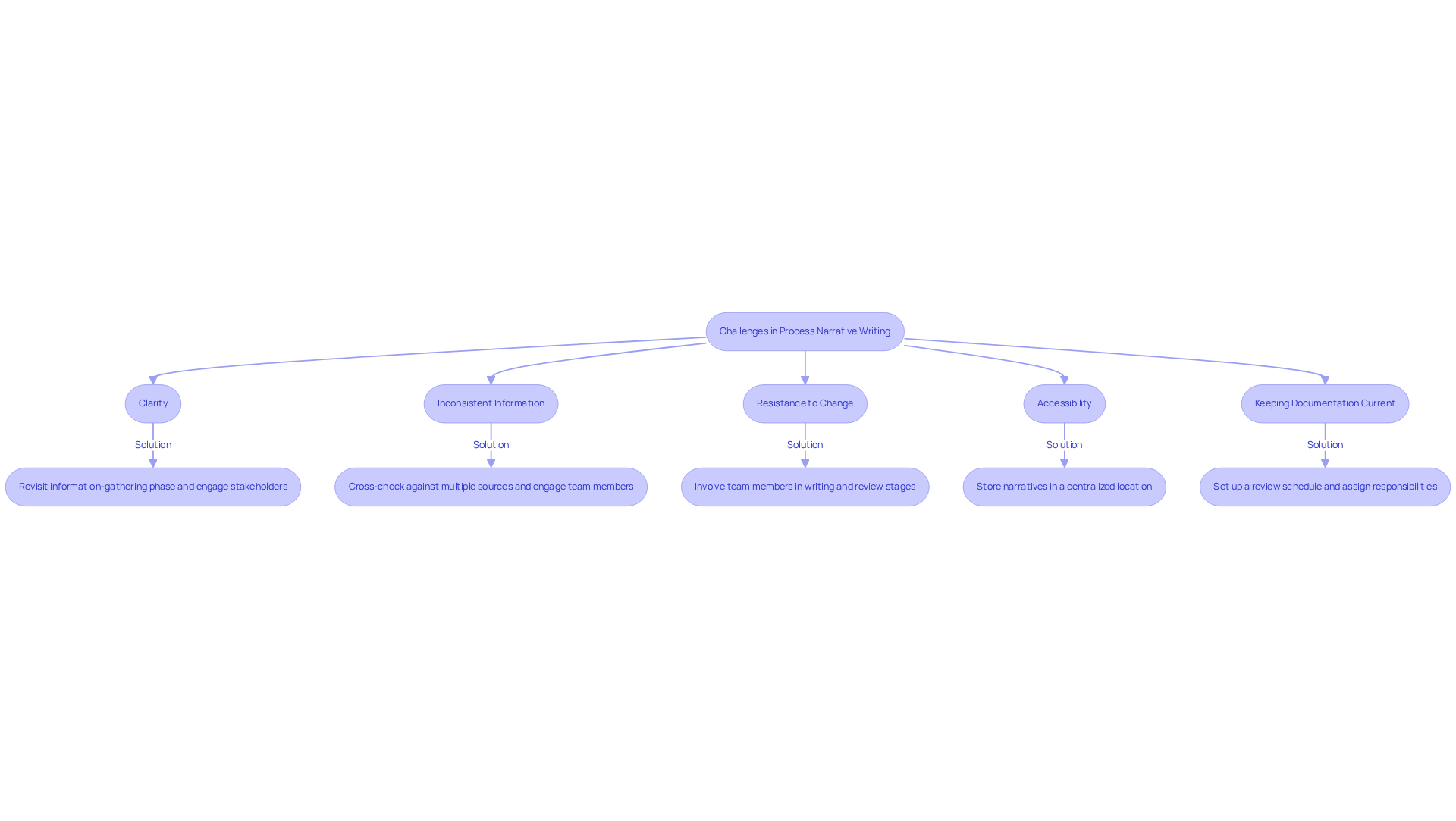
Process Improvement through Documentation
|
October 16, 2025
|
3 Steps to Write an Effective Process Narrative
Overview
You might be wondering how to write an effective process narrative. Well, it all boils down to three essential steps:
- Identifying procedures
- Gathering information
- Drafting the narrative
After that, don’t forget to review and finalize your document. It’s super important to get stakeholders involved and keep your documentation organized. Why, you ask? Because efficient process narratives can really boost training, onboarding, and even employee retention in your organization. So, let’s dive into how you can make this work for you!
Key Highlights:
- A process narrative outlines how specific processes operate within an organisation, detailing steps, responsibilities, and expected outcomes.
- Operational narratives improve training and onboarding, leading to increased employee retention and engagement.
- Efficient documentation can lead to a 50% increase in employee retention and 89% of employees value organised onboarding.
- Steps to write a process narrative include identifying procedures, gathering information, drafting the narrative, reviewing, and finalising the document.
- Stakeholder involvement is crucial for clarity and accuracy in process narratives.
- Challenges in writing process narratives include clarity issues, inconsistent information, resistance to change, accessibility, and keeping documentation current.
- Using tools like SowFlow can enhance documentation efficiency and accessibility, helping organisations maintain streamlined records.
Introduction
You might be wondering why crafting a compelling process narrative is so important for organizations looking to boost their operational efficiency and employee engagement. Well, these narratives act like detailed blueprints, guiding teams through the complexities of various procedures while fostering a culture of clarity and consistency.
But here’s the catch: many organizations struggle with effectively documenting these processes. So, how can teams sidestep common pitfalls and create narratives that not only inform but also empower their workforce? Let’s explore this together!
Define Process Narratives and Their Importance
You might be wondering what an operational account really is. Well, it’s basically a detailed look at the process narrative of how a specific process operates within an organization. It outlines the steps involved, who does what, and what outcomes to expect. These stories are super important for training and onboarding—they serve as essential resources that help improve consistency and efficiency in operations. By laying out workflows clearly, operational narratives help teams cut down on errors and boost overall productivity.
For instance, organizations that keep efficient documentation of their procedures have seen a whopping 50% increase in employee retention! Plus, 89% of employees say that a well-organized onboarding system really ramps up their engagement at work. This structured way of capturing and sharing knowledge not only makes it easier to access crucial info but also encourages a culture of continuous learning and development.
Speaking of that, take it from Anastasia Masadi, a Product Owner:
'SowFlow has been a game changer in the way we document work and deliver to our clients. I do not have to take each screenshot separately, and do not even have to leave the browser while I am creating SOPs and training materials. SowFlow gave me time from my life back.'
In essence, a process narrative is key for organizations aiming to boost their training and onboarding efforts, leading to a more skilled and committed workforce. So, why not explore how you can leverage this approach in your own organization?

Step-by-Step Guide to Writing a Process Narrative
- Identify the Procedure: So, you’re looking to kick things off by picking a procedure that’s crucial for your team or organization? Great choice! Involve your stakeholders to gather their insights on the project’s scope and goals. This way, you’ll ensure everything aligns with your organizational objectives. Did you know that organized onboarding can boost employee retention by a whopping 58%? It really shows how important it is to document those essential procedures!
- Gather Information: Next up, let’s dive into collecting all the juicy details about the procedure. This means chatting with your team members, checking out current records, and observing how things run in real-time. You want to grasp each step, the roles involved, and what tools or resources are in play. Here’s a fun fact: only about 4% of companies effectively monitor their procedures! That really highlights the need for thorough records. And hey, using SowFlow can make this info-gathering phase a breeze, allowing for quick updates to keep your documentation fresh.
- Draft the Story: Now, let’s start crafting the narrative. Outline the process narrative by arranging the steps in a logical order, using clear and concise language. Make sure to detail who’s responsible for what, the tools needed, and any bumps you might hit along the way. A well-organized process narrative not only clarifies confusion but also makes operations smoother. Organizations that embrace business workflow management (BPM) frameworks can see project success rates soar by up to 70%! That’s a solid reminder of how organized records can pave the way to operational success.
- Review and Revise: Once you have your draft, it’s time to share it with stakeholders for some feedback. Take their suggestions to heart and make revisions to boost clarity and accuracy. This collaborative vibe ensures your story is comprehensive and reflects the actual process—super important for effective implementation. Plus, SowFlow’s platform makes collaboration and updates a snap, so your records stay current and useful.
- Finalize and Distribute: After refining your narrative, it’s time to finalize the document and share it with your team. Make sure it’s easy to find—maybe use a centralized resource tool like SowFlow to keep it accessible for everyone. This is crucial because organizations often struggle with maintaining effective records, leading to inefficiencies and miscommunication. With SowFlow, you can keep your records streamlined and up-to-date, boosting overall team efficiency.

Troubleshoot Common Challenges in Process Narrative Writing
- You might be wondering about clarity. An ambiguous procedure description can really get in the way of effective communication. To make things clearer, it’s a good idea to revisit the information-gathering phase and chat with all relevant stakeholders. Simplifying complex language and breaking down steps into smaller, manageable parts can really boost understanding. For instance, organizations that have brought in automation tools have reported saving up to 520 hours a year—talk about the impact of clarity on efficiency!
- Now let’s talk about inconsistent information. Discrepancies in documentation can lead to confusion, right? To tackle this, cross-check your account against multiple sources and engage team members who regularly perform the process. Their insights can help validate the steps and ensure accuracy, creating a more trustworthy account. A case study on CareSource's use of VisibleThread shows just how improved clarity in documentation can lead to better strategic decision-making.
- You may also notice some resistance to change from team members when it comes to adopting new procedure narratives. To smooth things over, involve them in the process narrative during the writing and review stages. Highlighting the benefits of documented processes—like fewer errors and better efficiency—can really encourage buy-in and make transitions easier. As Lori Deaton, Market Implementation Manager at CareSource, points out, including group members can significantly enhance the acceptance of new methods.
- Speaking of accessibility, it’s crucial for effective materials. Ensure that the final process narrative is stored in a centralized location that is easily accessible for all team members. Using tools like SowFlow can simplify access and keep records up to date, minimizing delays in information retrieval. The importance of having a centralized system is clear, especially given the challenges many organizations face in keeping documentation current.
- Lastly, keeping documentation current is essential. Regularly reviewing the process narrative helps maintain its relevance. Setting up a review schedule and assigning specific team members the responsibility for updates ensures that records evolve alongside operational changes, enhancing overall clarity and effectiveness. Quality calibration should happen quarterly or biannually to keep consistency and accuracy in documentation.

Conclusion
Writing an effective process narrative is crucial for organizations looking to boost training and operational efficiency. You might be wondering how this works—well, by clearly documenting procedures, businesses can create a culture of learning and development. This, in turn, leads to better employee engagement and retention. Plus, a structured approach to crafting these narratives not only clarifies roles and responsibilities but also streamlines workflows, paving the way for a more productive workforce.
Now, let’s dive into what the article covered: a comprehensive step-by-step guide to crafting a process narrative. It emphasized the importance of:
- Identifying key procedures
- Gathering detailed information
- Drafting a clear and concise narrative
Collaboration during the review and revision stages is also a must, ensuring that the final document is accurate and accessible. By tackling common challenges like clarity, consistency, and resistance to change, organizations can effectively implement process narratives that become valuable resources for their teams.
Ultimately, embracing the practice of writing and maintaining process narratives can make a big difference in operational success. Organizations are encouraged to leverage tools like SowFlow to streamline documentation efforts and keep records current and accessible. By prioritizing clear communication and ongoing training, businesses can enhance their processes, empower their teams, and drive meaningful results. So, why not take the plunge? Your team will thank you for it!
Frequently Asked Questions
What is a process narrative?
A process narrative is a detailed account of how a specific process operates within an organization. It outlines the steps involved, the roles of individuals, and the expected outcomes.
Why are process narratives important?
Process narratives are crucial for training and onboarding as they help improve consistency and efficiency in operations. They clearly lay out workflows, which reduces errors and boosts overall productivity.
How do process narratives impact employee retention?
Organizations that maintain efficient documentation of their procedures have seen a 50% increase in employee retention.
What do employees think about organized onboarding systems?
89% of employees believe that a well-organized onboarding system significantly enhances their engagement at work.
How do process narratives contribute to a culture of learning?
By capturing and sharing knowledge in a structured manner, process narratives make it easier to access important information and encourage continuous learning and development within the organization.
Can you provide an example of a tool used for documenting processes?
SowFlow is an example of a tool that helps document work and create standard operating procedures (SOPs) and training materials efficiently, allowing users to work directly within their browser.
👍
What others are liking
5 Steps to outline your ideal documentation structure
5 MINS READ
Where to start the your journey of mapping out your ideal documentation structure, aligning it with the very heartbeat of your organization?
Defining a winning level of detail in your process
3 MINS READ
What is too much detail, and what is too little? This article described in that winning level detail about what detail is enough.





